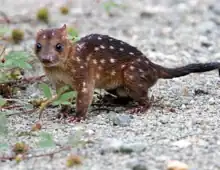New Guinean quoll
The New Guinean quoll (Dasyurus albopunctatus), also known as the New Guinea quoll or New Guinea native cat, is a carnivorous marsupial mammal native to New Guinea. It is the second-largest surviving marsupial carnivore of New Guinea.[note 1] It is known as suatg in the Kalam language of Papua New Guinea.[3]
| New Guinean quoll[1] | |
|---|---|
 | |
| Scientific classification | |
| Domain: | Eukaryota |
| Kingdom: | Animalia |
| Phylum: | Chordata |
| Class: | Mammalia |
| Infraclass: | Marsupialia |
| Order: | Dasyuromorphia |
| Family: | Dasyuridae |
| Genus: | Dasyurus |
| Species: | D. albopunctatus |
| Binomial name | |
| Dasyurus albopunctatus Schlegel, 1880 | |
 | |
| New Guinean quoll range | |
Taxonomy
The New Guinean quoll belongs to Dasyuridae, a family of carnivorous marsupials, which includes other species of quolls, the extinct thylacine, the Tasmanian devil, and many smaller carnivores. It is one of six extant species of quolls, four of which are found in only in Australia and two of which are restricted to New Guinea (the bronze quoll is the other New Guinean species). Both the quolls found in New Guinea seem to be most closely related to the Australian western quoll.
Description
The New Guinean quoll is small, usually weighing just over 1 lb (0.45 kg). Its body is brown and the back spotted with white; the spots do not extend onto the lightly haired tail. It resembles a cat-like opossum; the quolls are also referred to as "native cats" and occasionally "marsupial cats" or "tiger cats". Its feet have transversely striated pads, which is likely to be an adaptation for grip and is indicative of a life spent in the trees. It lives throughout the forests of New Guinea at elevations up to 11,000 ft (3300 m) but usually closer to 3,000 ft (900 m). The population appears to be centered in the highlands of New Guinea.
Behaviour and diet
Quolls feed on a large range of prey, including birds, rats, other marsupials, small reptiles, and insects. They are reported to feed on prey larger than themselves. They are good climbers, but also spend time on the forest floor. Although nocturnal, they spend the daylight hours basking in the sun. They nest in rocky banks, hollow logs, or small caves. In captivity, the longest recorded survival is three years, but their lifespan in the wild is unknown.
Threats
The number of New Guinean quolls is believed to be decreasing as a result of human encroachment into their habitat and the associated loss of cover. Because they are known to scavenge, persecution by humans may be putting pressure on the population. They also face predation and competition from introduced species such as dogs and cats.
Another threat, though less severe than with the four Australian species of Dasyurus, is poisoning by bufotoxins from the introduced cane toad (Rhinella marina, formerly Bufo marinus).[4] Because they have evolved consistently isolated from toads since the Jurassic, all dasyurids possess extremely low resistance to toad toxins,[5] and whilst smaller dasyurids usually do develop conditioned taste aversion to toads,[6] there is little evidence for this in quolls.
Notes
- Only the bronze quoll (Dasyurus spartacus) is larger.
References
- Groves, C. P. (2005). Wilson, D. E.; Reeder, D. M. (eds.). Mammal Species of the World: A Taxonomic and Geographic Reference (3rd ed.). Baltimore: Johns Hopkins University Press. p. 25. ISBN 0-801-88221-4. OCLC 62265494.
- Woolley, P.; Leary, T.; Seri, L.; Flannery, T.; Wright, D.; Hamilton, S.; Helgen, K.; Singadan, R.; Menzies, J.; Allison, A.; James, R. (2016). "Dasyurus albopunctatus". IUCN Red List of Threatened Species. 2016: e.T6299A21946965. doi:10.2305/IUCN.UK.2016-2.RLTS.T6299A21946965.en. Retrieved 11 November 2021.
- Pawley, Andrew and Ralph Bulmer. 2011. A Dictionary of Kalam with Ethnographic Notes. Canberra. Pacific Linguistics.
- Government of Queensland (2009); Invasive Animal Risk Assessment: Cane toad (Bufo marinus)
- Covacevich, Jeanette, and Archer, Mike; ‘The distribution of the cane toad, Bufo marinus in Australia and its effects on indigenous vertebrates’; Memoirs of the Queensland Museum, volume 17 (1975), pp. 305–310.
- Webb, Jonathan K.; Pearson, David and Shine, Richard; ‘A small dasyurid predator (Sminthopsis virginiae) rapidly learns to avoid a toxic invader’; Wildlife Research, issue 38 (2011), pp. 726–731
- "What lives there?". Worldwide Fund for Nature. Archived from the original on 11 February 2012. Retrieved 23 November 2006.
- "Longevity Records Life Spans of Mammals, Birds, Amphibians, Reptiles, and Fish". Max Planck Institute for Demographic Research. Archived from the original on 6 October 2006. Retrieved 23 November 2006.
- . Encyclopædia Britannica. Vol. 7 (11th ed.). 1911. p. 845.
